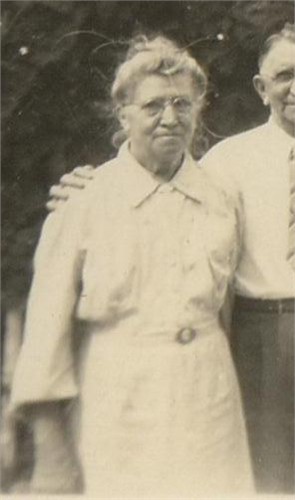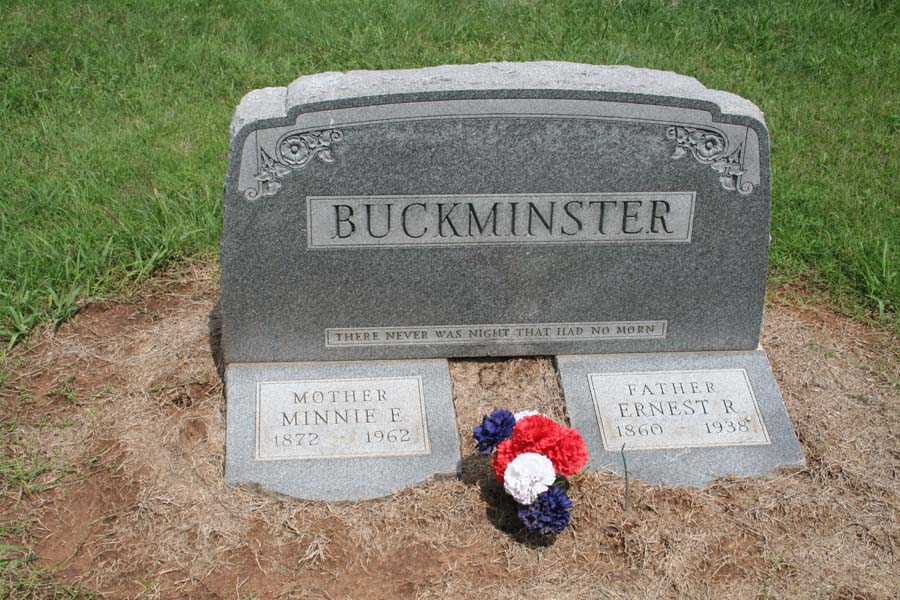The Chikaskia River was up at Coffeyville, KS, and after much persuasion by one of Ernest's brothers, they forded the river safely, but everything in the wagon got wet. Three days were spent drying out their belongings. After arriving in Okarche, they spent the summer in a 12' x 12' shanty with walls 1" thick. This is where Minnie gave birth to their son, Lewis, in August, 1893.
Ernest's older brother insisted they ride into the Strip area and locate a choice site before the run. Reluctantly Ernest agreed, for only Civil War veterans were permitted to scout prior to the actual run and neither of them met that requirement. They had not gone far when Ernest said; "Whoa!" turned to his brother and said, "If I cannot get a claim honestly, I don't want one." He rode back to Okarche. On September 10th, Ernest and Minnie, with little Lewis, left Okarche for Hennessey near the south boundary of the Cherokee Strip.
At high noon on the 16th, the sound of the gunshot opening the Cherokee Strip for settlement rang out. Ernest spurred his white horse bound for the northern side of the Strip while Minnie stayed in the wagon with little Lewis in Hennessey. It was a tremendously hot day in what had been a long drought. The temperature that day reached 100°. Ernest had intended to go further than he did, but his horse stepped in a hole causing it to go lame. So, he put down his stake on N.E. 28/22/8.
After he returned from recording his claim at the newly established land office in Enid, E.R. found another man trying to remove his stake and replace it with his own. The story is somewhat vague about what happened next, but guns were drawn and the interloper left quickly. E.R.'s claim was just to the southeast of present day Lahoma and their first "house" was a tent stretched over a dugout.
It is hard for me to imagine how they survived those first few months. The growing season was over until the following spring and the creeks were all but dry due to the drought. But, Ernest broke the sod with a walking plow pulled by the small team which brought them from Missouri and planned for their future. One day a rattlesnake crawled into the dugout close to little Lewis; Minnie felt helpless and just watched, without moving until the snake crawled back out.
As winter was setting in, Ernest took Minnie and Lewis to Caldwell, KS, to catch a train for Missouri where they would stay with her parents until spring. To earn much needed money, Ernest would go to the timber area to the west of his claim and cut wood which he would sell in Enid for $1 a load.
Ernest and Minnie farmed, raised cattle, bought more land and became very successful through the years. In the early days, Ernest was Justice of the Peace, helped organize the Dickerson School to the east of their homestead, became active in politics and helped establish the first telephone service and Co-op grain elevator in Lahoma. When a black family moved to the area, he led the effort to establish a school close to the family's home (this was in the days of segregation). Ernest and Minnie had six children, one of which was my grandmother, Irene Buckminster Coppock.
But there were hard times too. Lewis, the baby born in that shanty awaiting the land run, died in 1912 at the age of 19 from tuberculosis. A younger daughter, Zelma, died at 9 months from pneumonia. The 1930's brought the dust bowl and ruined crops. But through all of this, they held onto the land they laid claim to in 1893.
The Chikaskia River was up at Coffeyville, KS, and after much persuasion by one of Ernest's brothers, they forded the river safely, but everything in the wagon got wet. Three days were spent drying out their belongings. After arriving in Okarche, they spent the summer in a 12' x 12' shanty with walls 1" thick. This is where Minnie gave birth to their son, Lewis, in August, 1893.
Ernest's older brother insisted they ride into the Strip area and locate a choice site before the run. Reluctantly Ernest agreed, for only Civil War veterans were permitted to scout prior to the actual run and neither of them met that requirement. They had not gone far when Ernest said; "Whoa!" turned to his brother and said, "If I cannot get a claim honestly, I don't want one." He rode back to Okarche. On September 10th, Ernest and Minnie, with little Lewis, left Okarche for Hennessey near the south boundary of the Cherokee Strip.
At high noon on the 16th, the sound of the gunshot opening the Cherokee Strip for settlement rang out. Ernest spurred his white horse bound for the northern side of the Strip while Minnie stayed in the wagon with little Lewis in Hennessey. It was a tremendously hot day in what had been a long drought. The temperature that day reached 100°. Ernest had intended to go further than he did, but his horse stepped in a hole causing it to go lame. So, he put down his stake on N.E. 28/22/8.
After he returned from recording his claim at the newly established land office in Enid, E.R. found another man trying to remove his stake and replace it with his own. The story is somewhat vague about what happened next, but guns were drawn and the interloper left quickly. E.R.'s claim was just to the southeast of present day Lahoma and their first "house" was a tent stretched over a dugout.
It is hard for me to imagine how they survived those first few months. The growing season was over until the following spring and the creeks were all but dry due to the drought. But, Ernest broke the sod with a walking plow pulled by the small team which brought them from Missouri and planned for their future. One day a rattlesnake crawled into the dugout close to little Lewis; Minnie felt helpless and just watched, without moving until the snake crawled back out.
As winter was setting in, Ernest took Minnie and Lewis to Caldwell, KS, to catch a train for Missouri where they would stay with her parents until spring. To earn much needed money, Ernest would go to the timber area to the west of his claim and cut wood which he would sell in Enid for $1 a load.
Ernest and Minnie farmed, raised cattle, bought more land and became very successful through the years. In the early days, Ernest was Justice of the Peace, helped organize the Dickerson School to the east of their homestead, became active in politics and helped establish the first telephone service and Co-op grain elevator in Lahoma. When a black family moved to the area, he led the effort to establish a school close to the family's home (this was in the days of segregation). Ernest and Minnie had six children, one of which was my grandmother, Irene Buckminster Coppock.
But there were hard times too. Lewis, the baby born in that shanty awaiting the land run, died in 1912 at the age of 19 from tuberculosis. A younger daughter, Zelma, died at 9 months from pneumonia. The 1930's brought the dust bowl and ruined crops. But through all of this, they held onto the land they laid claim to in 1893.
Family Members
Sponsored by Ancestry
Advertisement
See more Buckminster or Horn memorials in:
- Sunnyside Cemetery Buckminster or Horn
- Lahoma Buckminster or Horn
- Garfield County Buckminster or Horn
- Oklahoma Buckminster or Horn
- USA Buckminster or Horn
- Find a Grave Buckminster or Horn
Advertisement























